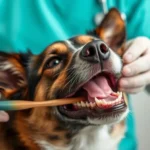
Introduction
Foaming at the mouth in dogs can be a concerning sight for any pet owner. This phenomenon, which often manifests as a frothy or bubbly substance around a dog’s mouth, can range from benign to alarming. Understanding why dogs foam at the mouth is crucial for pet owners, as it can indicate various conditions or situations that require attention.
In this article, we will explore the potential causes of foaming at the mouth, ranging from medical issues to behavioral factors. We will also discuss when it’s essential to seek veterinary help, the diagnostic process involved, and treatment options available. By being informed, you can take proactive steps to ensure your dog’s health and well-being.
Understanding Foaming at the Mouth
What is Foaming at the Mouth?
Foaming at the mouth occurs when a dog produces excess saliva that mixes with air, creating a frothy appearance. While normal saliva production helps with digestion and oral hygiene, excessive foaming can be a sign of something more serious.
Common Triggers for Foaming
There are several triggers that can cause foaming at the mouth in dogs. These include:
- Excitement or Anxiety: A dog may foam at the mouth during highly stimulating situations, such as playtime or stressful events.
- Physical Exertion: Intense exercise can lead to increased salivation, especially in hot weather.
- Environmental Factors: Conditions like heat and humidity can exacerbate a dog’s natural tendency to salivate.
Understanding these triggers is the first step in determining whether foaming at the mouth is a cause for concern.
Potential Causes of Foaming at the Mouth
Medical Conditions
Several medical conditions can lead to foaming at the mouth. Here are some of the most common:
Rabies
Rabies is a viral disease that affects the nervous system and can cause severe symptoms, including foaming at the mouth. Infected dogs may also exhibit behavioral changes, such as aggression or lethargy. The importance of vaccinating your dog against rabies cannot be overstated, as it is a preventable disease.
Seizures
Seizures can cause dogs to foam at the mouth due to muscle contractions and the inability to swallow. Different types of seizures may present various symptoms, such as twitching, loss of consciousness, or uncontrolled movements. If you notice foaming during or after a seizure, it’s essential to consult a veterinarian.
Poisoning
Foaming at the mouth can also be a sign of poisoning. Common toxins that affect dogs include certain plants, chemicals, and human foods like chocolate or grapes. Along with foaming, other signs of poisoning may include vomiting, diarrhea, or lethargy. If you suspect your dog has ingested a toxin, seek immediate veterinary attention.
Behavioral Factors
Aside from medical conditions, several behavioral factors can lead to foaming at the mouth:
Stress and Anxiety
Stressful situations, such as thunderstorms or fireworks, can trigger anxiety in dogs, leading to excessive salivation and foaming. Behavioral indicators of stress may include panting, pacing, or hiding.
Overheating
Overheating is another critical factor that can cause foaming at the mouth. Signs of heatstroke include excessive panting, drooling, and lethargy. It’s crucial to monitor your dog in hot weather and provide plenty of water and shade to prevent overheating.
When to Seek Veterinary Help
Identifying Emergencies
Knowing when to seek veterinary help is vital for your dog’s health. Some symptoms that require immediate attention include:
- Persistent foaming at the mouth without clear cause
- Signs of distress, such as pacing or whining
- Behavioral changes, including aggression or lethargy
- Other symptoms like vomiting, diarrhea, or seizures
If your dog exhibits a combination of these symptoms, it’s essential to consult with your veterinarian as soon as possible.
Preparing for the Vet Visit
When preparing for a vet visit, gather relevant information such as:
- Detailed history of the foaming episodes
- Any recent changes in your dog’s environment or routine
- List of food or substances your dog may have ingested
Additionally, consider asking your veterinarian about potential causes, diagnostic tests, and treatment options.
Diagnostic Process
Veterinary Examination
During a vet visit, you can expect a thorough examination of your dog. The veterinarian will assess the overall health and behavior of your pet. Common tests may include:
- Blood work: To check for underlying medical conditions.
- Urinalysis: To assess kidney function and hydration levels.
- Imaging: Such as X-rays, if needed to visualize internal issues.
Differential Diagnosis
Veterinarians use a method called differential diagnosis to differentiate between potential causes of foaming at the mouth. This process involves considering various medical conditions and ruling them out based on your dog’s symptoms, history, and examination findings.
Treatment Options
Medical Interventions
Treatment for foaming at the mouth largely depends on the underlying cause. For example:
- Rabies: There is no treatment for rabies once symptoms appear, which is why vaccination is crucial.
- Seizures: Medications can help manage seizures and reduce their frequency.
- Poisoning: Depending on the toxin, treatment may involve inducing vomiting, administering activated charcoal, or providing supportive care.
Behavioral Solutions
If foaming is related to stress or anxiety, various behavioral solutions may help:
- Training techniques: Positive reinforcement can help manage anxiety.
- Desensitization: Gradual exposure to stressors can reduce fear responses.
- Cooling strategies: To prevent overheating, keep your dog in a shaded area and provide plenty of water.
Preventive Measures
Routine Check-ups
Regular veterinary visits play a crucial role in your dog’s health. Routine check-ups allow for vaccinations, early detection of health issues, and guidance on proper care. Keeping your dog’s vaccinations up to date protects against serious diseases like rabies.
Environmental Management
Creating a safe and comfortable environment for your dog can significantly reduce the risk of foaming at the mouth. Consider the following tips:
- Ensure your dog has access to fresh water and shade, especially in hot weather.
- Identify and minimize stressors in your dog’s environment, such as loud noises or unfamiliar animals.
- Provide a quiet space for your dog to retreat to during stressful situations.
Conclusion
In summary, foaming at the mouth in dogs can result from various causes, ranging from benign situations to serious medical conditions. By understanding the symptoms and potential triggers, pet owners can take proactive steps to ensure their dog’s health and well-being. Regular veterinary visits, environmental management, and awareness of your dog’s behavior are essential components of responsible pet ownership.
If you notice your dog foaming at the mouth, it’s crucial to monitor the situation closely and consult your veterinarian for guidance. Being informed and proactive can make a significant difference in your dog’s health and safety.









